Climate Change and Human Health: Risks, Impacts, and Adaptations
VerifiedAdded on 2020/02/18
|8
|2104
|71
Report
AI Summary
This report provides a comprehensive review of the existing literature on climate change and its effects on human health. It synthesizes findings from multiple sources, including journal articles and research reviews, to illustrate the various ways in which climate change poses risks to human populations. The report covers a range of topics, such as the impact of extreme weather events, changes in air quality, and the spread of infectious diseases. It also examines the effects of climate change on biodiversity and the marine environment, highlighting the potential consequences for human health. Furthermore, the report analyzes different public health adaptation strategies that have been proposed and implemented to address the health impacts of climate change. It emphasizes the need for both mitigation and adaptation measures at national and international levels to reduce greenhouse gas emissions and protect human health. The report concludes by underscoring the importance of further research to fully understand the complex relationship between climate change and human health and to develop effective interventions.
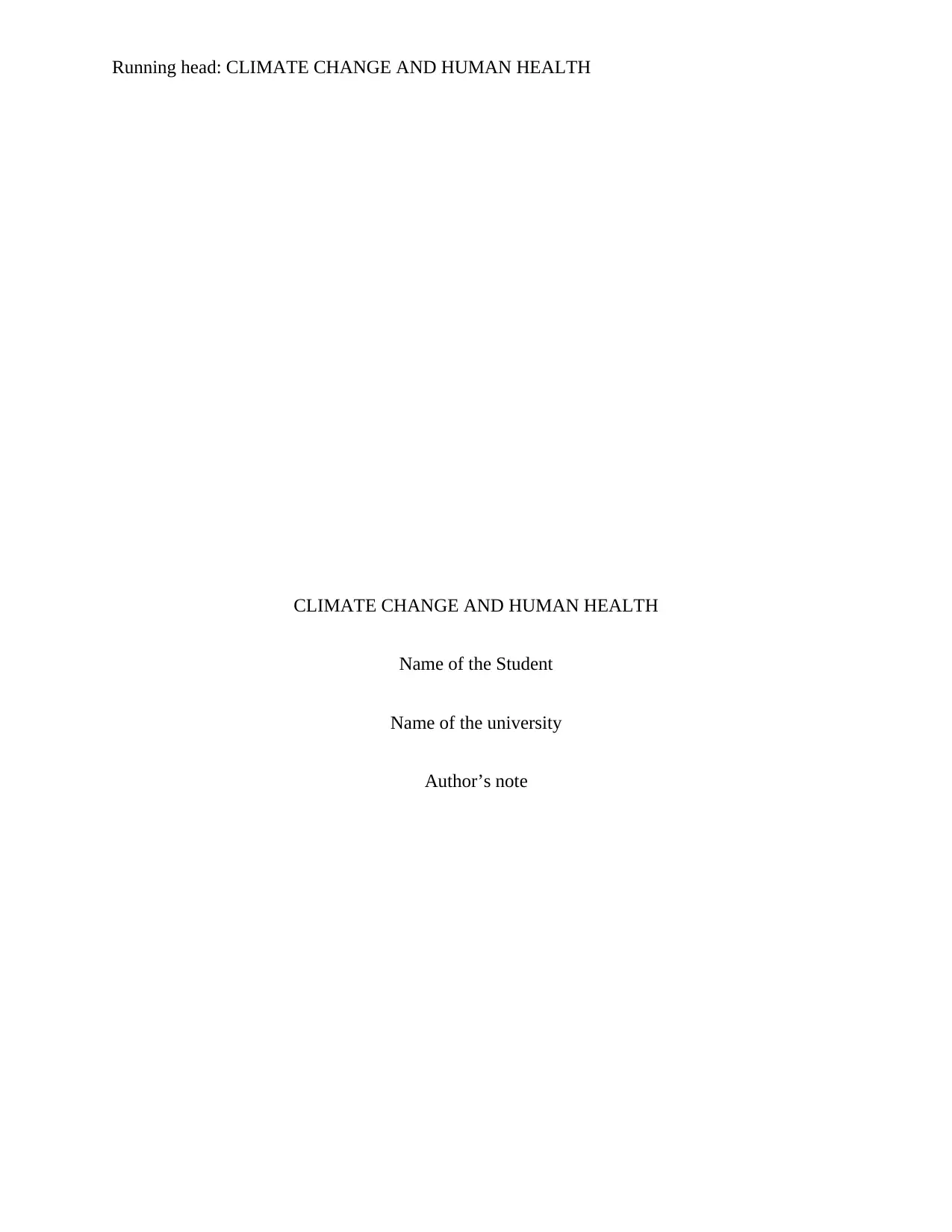
Running head: CLIMATE CHANGE AND HUMAN HEALTH
CLIMATE CHANGE AND HUMAN HEALTH
Name of the Student
Name of the university
Author’s note
CLIMATE CHANGE AND HUMAN HEALTH
Name of the Student
Name of the university
Author’s note
Paraphrase This Document
Need a fresh take? Get an instant paraphrase of this document with our AI Paraphraser
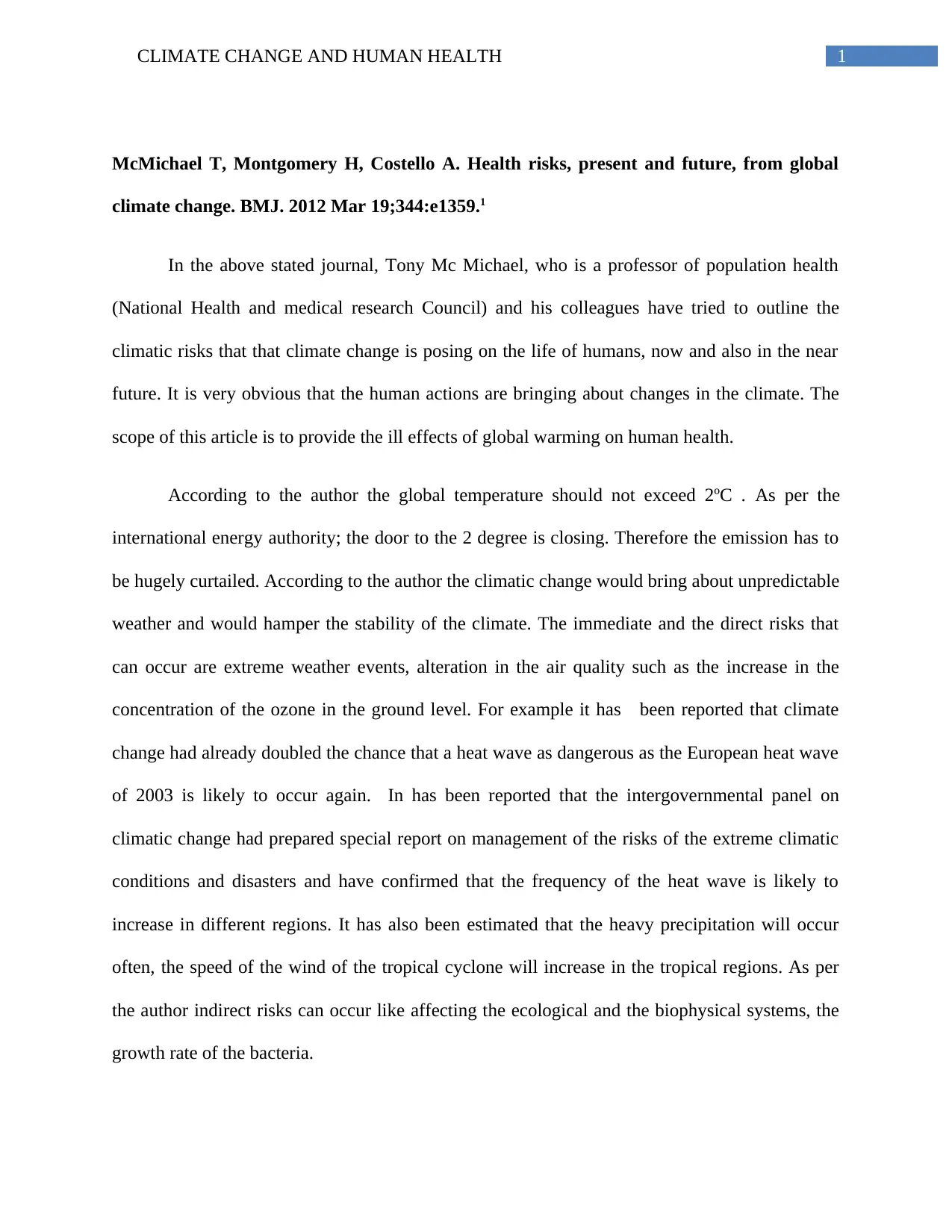
1CLIMATE CHANGE AND HUMAN HEALTH
McMichael T, Montgomery H, Costello A. Health risks, present and future, from global
climate change. BMJ. 2012 Mar 19;344:e1359.1
In the above stated journal, Tony Mc Michael, who is a professor of population health
(National Health and medical research Council) and his colleagues have tried to outline the
climatic risks that that climate change is posing on the life of humans, now and also in the near
future. It is very obvious that the human actions are bringing about changes in the climate. The
scope of this article is to provide the ill effects of global warming on human health.
According to the author the global temperature should not exceed 2ºC . As per the
international energy authority; the door to the 2 degree is closing. Therefore the emission has to
be hugely curtailed. According to the author the climatic change would bring about unpredictable
weather and would hamper the stability of the climate. The immediate and the direct risks that
can occur are extreme weather events, alteration in the air quality such as the increase in the
concentration of the ozone in the ground level. For example it has been reported that climate
change had already doubled the chance that a heat wave as dangerous as the European heat wave
of 2003 is likely to occur again. In has been reported that the intergovernmental panel on
climatic change had prepared special report on management of the risks of the extreme climatic
conditions and disasters and have confirmed that the frequency of the heat wave is likely to
increase in different regions. It has also been estimated that the heavy precipitation will occur
often, the speed of the wind of the tropical cyclone will increase in the tropical regions. As per
the author indirect risks can occur like affecting the ecological and the biophysical systems, the
growth rate of the bacteria.
McMichael T, Montgomery H, Costello A. Health risks, present and future, from global
climate change. BMJ. 2012 Mar 19;344:e1359.1
In the above stated journal, Tony Mc Michael, who is a professor of population health
(National Health and medical research Council) and his colleagues have tried to outline the
climatic risks that that climate change is posing on the life of humans, now and also in the near
future. It is very obvious that the human actions are bringing about changes in the climate. The
scope of this article is to provide the ill effects of global warming on human health.
According to the author the global temperature should not exceed 2ºC . As per the
international energy authority; the door to the 2 degree is closing. Therefore the emission has to
be hugely curtailed. According to the author the climatic change would bring about unpredictable
weather and would hamper the stability of the climate. The immediate and the direct risks that
can occur are extreme weather events, alteration in the air quality such as the increase in the
concentration of the ozone in the ground level. For example it has been reported that climate
change had already doubled the chance that a heat wave as dangerous as the European heat wave
of 2003 is likely to occur again. In has been reported that the intergovernmental panel on
climatic change had prepared special report on management of the risks of the extreme climatic
conditions and disasters and have confirmed that the frequency of the heat wave is likely to
increase in different regions. It has also been estimated that the heavy precipitation will occur
often, the speed of the wind of the tropical cyclone will increase in the tropical regions. As per
the author indirect risks can occur like affecting the ecological and the biophysical systems, the
growth rate of the bacteria.
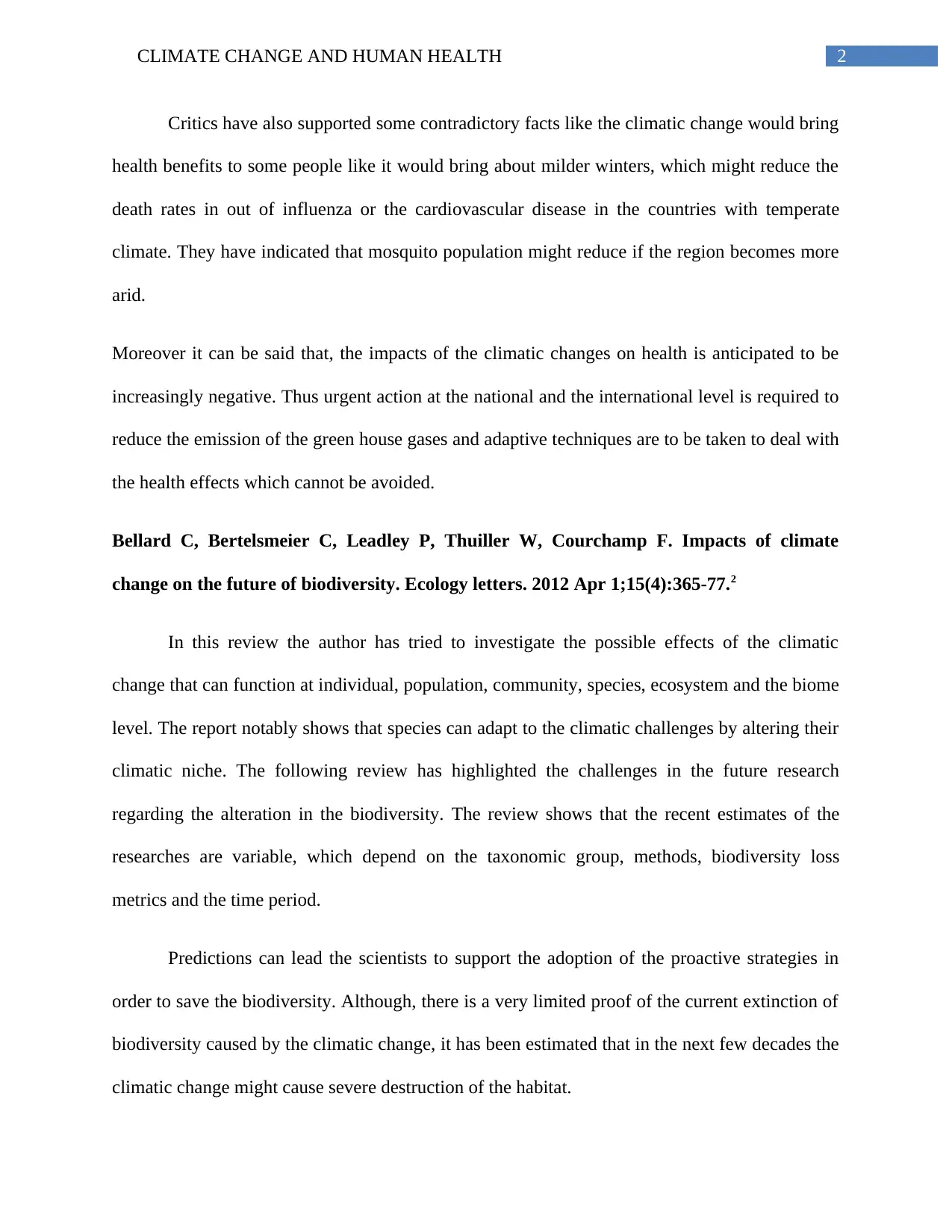
2CLIMATE CHANGE AND HUMAN HEALTH
Critics have also supported some contradictory facts like the climatic change would bring
health benefits to some people like it would bring about milder winters, which might reduce the
death rates in out of influenza or the cardiovascular disease in the countries with temperate
climate. They have indicated that mosquito population might reduce if the region becomes more
arid.
Moreover it can be said that, the impacts of the climatic changes on health is anticipated to be
increasingly negative. Thus urgent action at the national and the international level is required to
reduce the emission of the green house gases and adaptive techniques are to be taken to deal with
the health effects which cannot be avoided.
Bellard C, Bertelsmeier C, Leadley P, Thuiller W, Courchamp F. Impacts of climate
change on the future of biodiversity. Ecology letters. 2012 Apr 1;15(4):365-77.2
In this review the author has tried to investigate the possible effects of the climatic
change that can function at individual, population, community, species, ecosystem and the biome
level. The report notably shows that species can adapt to the climatic challenges by altering their
climatic niche. The following review has highlighted the challenges in the future research
regarding the alteration in the biodiversity. The review shows that the recent estimates of the
researches are variable, which depend on the taxonomic group, methods, biodiversity loss
metrics and the time period.
Predictions can lead the scientists to support the adoption of the proactive strategies in
order to save the biodiversity. Although, there is a very limited proof of the current extinction of
biodiversity caused by the climatic change, it has been estimated that in the next few decades the
climatic change might cause severe destruction of the habitat.
Critics have also supported some contradictory facts like the climatic change would bring
health benefits to some people like it would bring about milder winters, which might reduce the
death rates in out of influenza or the cardiovascular disease in the countries with temperate
climate. They have indicated that mosquito population might reduce if the region becomes more
arid.
Moreover it can be said that, the impacts of the climatic changes on health is anticipated to be
increasingly negative. Thus urgent action at the national and the international level is required to
reduce the emission of the green house gases and adaptive techniques are to be taken to deal with
the health effects which cannot be avoided.
Bellard C, Bertelsmeier C, Leadley P, Thuiller W, Courchamp F. Impacts of climate
change on the future of biodiversity. Ecology letters. 2012 Apr 1;15(4):365-77.2
In this review the author has tried to investigate the possible effects of the climatic
change that can function at individual, population, community, species, ecosystem and the biome
level. The report notably shows that species can adapt to the climatic challenges by altering their
climatic niche. The following review has highlighted the challenges in the future research
regarding the alteration in the biodiversity. The review shows that the recent estimates of the
researches are variable, which depend on the taxonomic group, methods, biodiversity loss
metrics and the time period.
Predictions can lead the scientists to support the adoption of the proactive strategies in
order to save the biodiversity. Although, there is a very limited proof of the current extinction of
biodiversity caused by the climatic change, it has been estimated that in the next few decades the
climatic change might cause severe destruction of the habitat.
⊘ This is a preview!⊘
Do you want full access?
Subscribe today to unlock all pages.

Trusted by 1+ million students worldwide
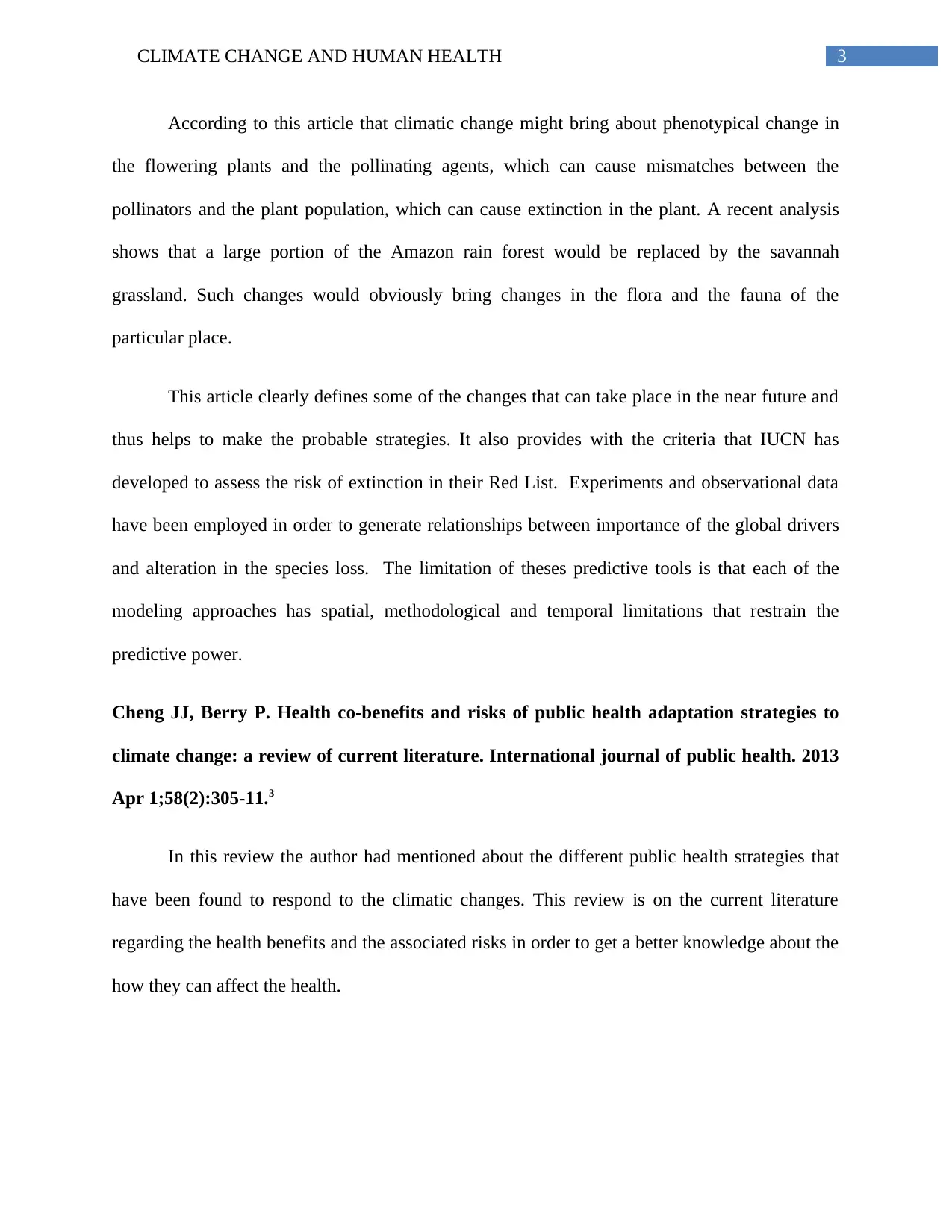
3CLIMATE CHANGE AND HUMAN HEALTH
According to this article that climatic change might bring about phenotypical change in
the flowering plants and the pollinating agents, which can cause mismatches between the
pollinators and the plant population, which can cause extinction in the plant. A recent analysis
shows that a large portion of the Amazon rain forest would be replaced by the savannah
grassland. Such changes would obviously bring changes in the flora and the fauna of the
particular place.
This article clearly defines some of the changes that can take place in the near future and
thus helps to make the probable strategies. It also provides with the criteria that IUCN has
developed to assess the risk of extinction in their Red List. Experiments and observational data
have been employed in order to generate relationships between importance of the global drivers
and alteration in the species loss. The limitation of theses predictive tools is that each of the
modeling approaches has spatial, methodological and temporal limitations that restrain the
predictive power.
Cheng JJ, Berry P. Health co-benefits and risks of public health adaptation strategies to
climate change: a review of current literature. International journal of public health. 2013
Apr 1;58(2):305-11.3
In this review the author had mentioned about the different public health strategies that
have been found to respond to the climatic changes. This review is on the current literature
regarding the health benefits and the associated risks in order to get a better knowledge about the
how they can affect the health.
According to this article that climatic change might bring about phenotypical change in
the flowering plants and the pollinating agents, which can cause mismatches between the
pollinators and the plant population, which can cause extinction in the plant. A recent analysis
shows that a large portion of the Amazon rain forest would be replaced by the savannah
grassland. Such changes would obviously bring changes in the flora and the fauna of the
particular place.
This article clearly defines some of the changes that can take place in the near future and
thus helps to make the probable strategies. It also provides with the criteria that IUCN has
developed to assess the risk of extinction in their Red List. Experiments and observational data
have been employed in order to generate relationships between importance of the global drivers
and alteration in the species loss. The limitation of theses predictive tools is that each of the
modeling approaches has spatial, methodological and temporal limitations that restrain the
predictive power.
Cheng JJ, Berry P. Health co-benefits and risks of public health adaptation strategies to
climate change: a review of current literature. International journal of public health. 2013
Apr 1;58(2):305-11.3
In this review the author had mentioned about the different public health strategies that
have been found to respond to the climatic changes. This review is on the current literature
regarding the health benefits and the associated risks in order to get a better knowledge about the
how they can affect the health.
Paraphrase This Document
Need a fresh take? Get an instant paraphrase of this document with our AI Paraphraser
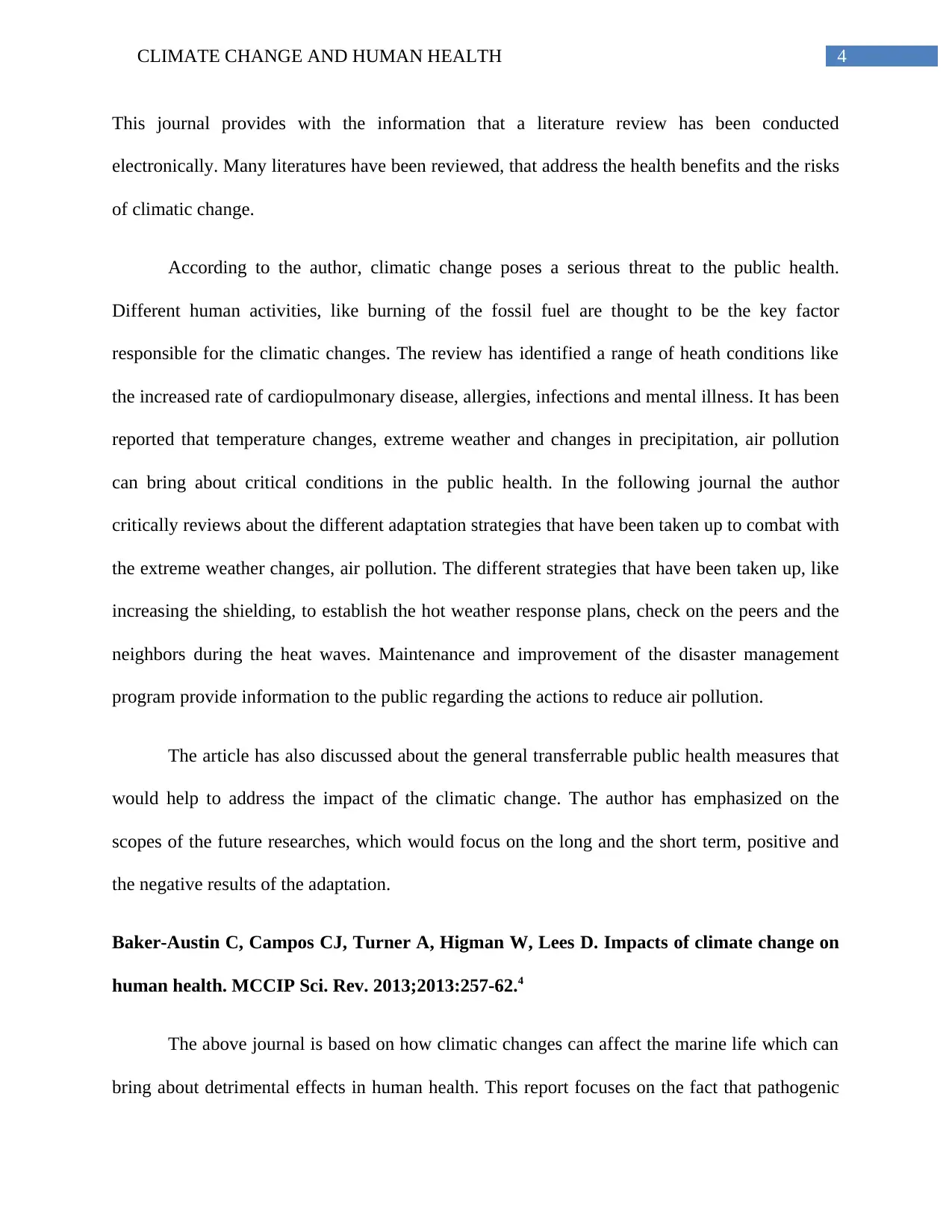
4CLIMATE CHANGE AND HUMAN HEALTH
This journal provides with the information that a literature review has been conducted
electronically. Many literatures have been reviewed, that address the health benefits and the risks
of climatic change.
According to the author, climatic change poses a serious threat to the public health.
Different human activities, like burning of the fossil fuel are thought to be the key factor
responsible for the climatic changes. The review has identified a range of heath conditions like
the increased rate of cardiopulmonary disease, allergies, infections and mental illness. It has been
reported that temperature changes, extreme weather and changes in precipitation, air pollution
can bring about critical conditions in the public health. In the following journal the author
critically reviews about the different adaptation strategies that have been taken up to combat with
the extreme weather changes, air pollution. The different strategies that have been taken up, like
increasing the shielding, to establish the hot weather response plans, check on the peers and the
neighbors during the heat waves. Maintenance and improvement of the disaster management
program provide information to the public regarding the actions to reduce air pollution.
The article has also discussed about the general transferrable public health measures that
would help to address the impact of the climatic change. The author has emphasized on the
scopes of the future researches, which would focus on the long and the short term, positive and
the negative results of the adaptation.
Baker-Austin C, Campos CJ, Turner A, Higman W, Lees D. Impacts of climate change on
human health. MCCIP Sci. Rev. 2013;2013:257-62.4
The above journal is based on how climatic changes can affect the marine life which can
bring about detrimental effects in human health. This report focuses on the fact that pathogenic
This journal provides with the information that a literature review has been conducted
electronically. Many literatures have been reviewed, that address the health benefits and the risks
of climatic change.
According to the author, climatic change poses a serious threat to the public health.
Different human activities, like burning of the fossil fuel are thought to be the key factor
responsible for the climatic changes. The review has identified a range of heath conditions like
the increased rate of cardiopulmonary disease, allergies, infections and mental illness. It has been
reported that temperature changes, extreme weather and changes in precipitation, air pollution
can bring about critical conditions in the public health. In the following journal the author
critically reviews about the different adaptation strategies that have been taken up to combat with
the extreme weather changes, air pollution. The different strategies that have been taken up, like
increasing the shielding, to establish the hot weather response plans, check on the peers and the
neighbors during the heat waves. Maintenance and improvement of the disaster management
program provide information to the public regarding the actions to reduce air pollution.
The article has also discussed about the general transferrable public health measures that
would help to address the impact of the climatic change. The author has emphasized on the
scopes of the future researches, which would focus on the long and the short term, positive and
the negative results of the adaptation.
Baker-Austin C, Campos CJ, Turner A, Higman W, Lees D. Impacts of climate change on
human health. MCCIP Sci. Rev. 2013;2013:257-62.4
The above journal is based on how climatic changes can affect the marine life which can
bring about detrimental effects in human health. This report focuses on the fact that pathogenic
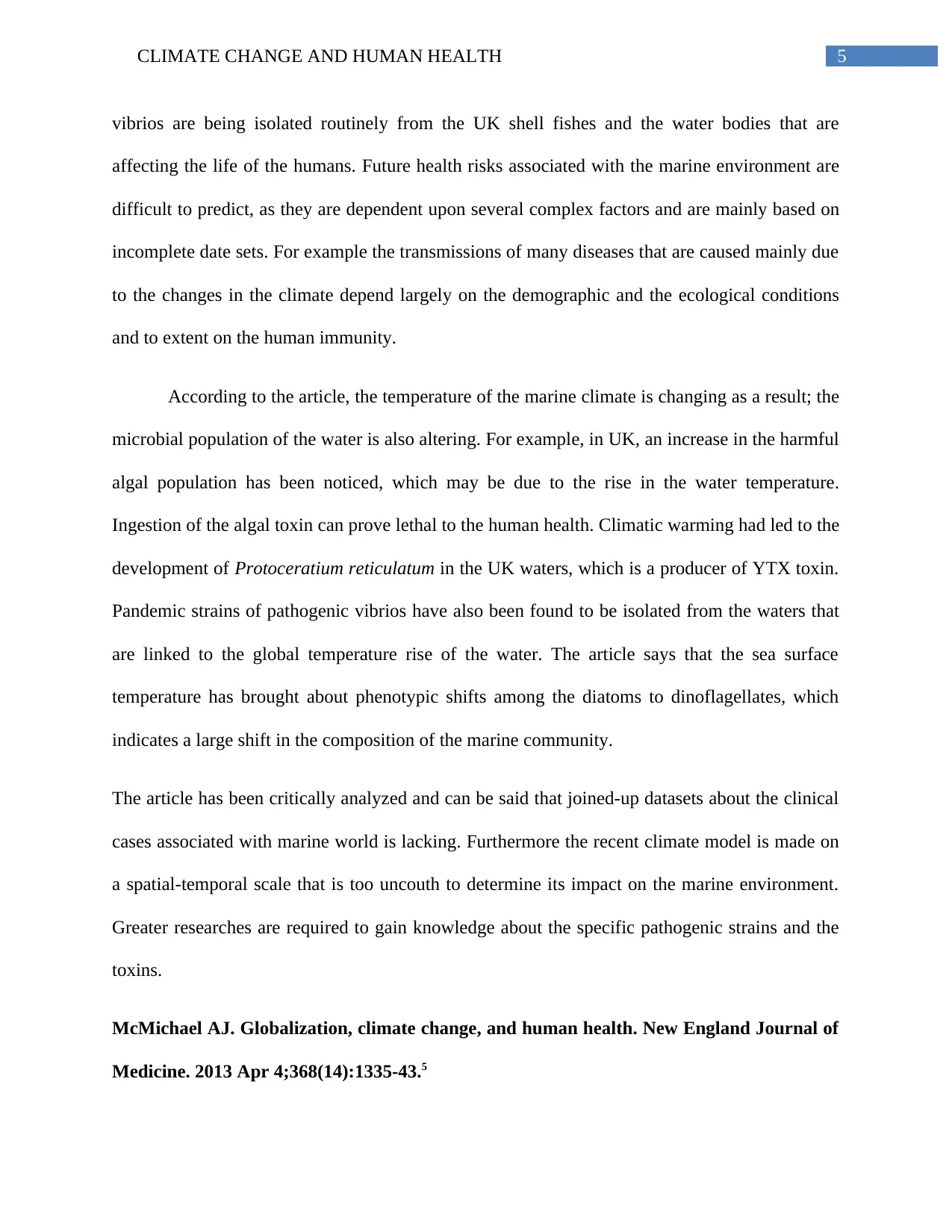
5CLIMATE CHANGE AND HUMAN HEALTH
vibrios are being isolated routinely from the UK shell fishes and the water bodies that are
affecting the life of the humans. Future health risks associated with the marine environment are
difficult to predict, as they are dependent upon several complex factors and are mainly based on
incomplete date sets. For example the transmissions of many diseases that are caused mainly due
to the changes in the climate depend largely on the demographic and the ecological conditions
and to extent on the human immunity.
According to the article, the temperature of the marine climate is changing as a result; the
microbial population of the water is also altering. For example, in UK, an increase in the harmful
algal population has been noticed, which may be due to the rise in the water temperature.
Ingestion of the algal toxin can prove lethal to the human health. Climatic warming had led to the
development of Protoceratium reticulatum in the UK waters, which is a producer of YTX toxin.
Pandemic strains of pathogenic vibrios have also been found to be isolated from the waters that
are linked to the global temperature rise of the water. The article says that the sea surface
temperature has brought about phenotypic shifts among the diatoms to dinoflagellates, which
indicates a large shift in the composition of the marine community.
The article has been critically analyzed and can be said that joined-up datasets about the clinical
cases associated with marine world is lacking. Furthermore the recent climate model is made on
a spatial-temporal scale that is too uncouth to determine its impact on the marine environment.
Greater researches are required to gain knowledge about the specific pathogenic strains and the
toxins.
McMichael AJ. Globalization, climate change, and human health. New England Journal of
Medicine. 2013 Apr 4;368(14):1335-43.5
vibrios are being isolated routinely from the UK shell fishes and the water bodies that are
affecting the life of the humans. Future health risks associated with the marine environment are
difficult to predict, as they are dependent upon several complex factors and are mainly based on
incomplete date sets. For example the transmissions of many diseases that are caused mainly due
to the changes in the climate depend largely on the demographic and the ecological conditions
and to extent on the human immunity.
According to the article, the temperature of the marine climate is changing as a result; the
microbial population of the water is also altering. For example, in UK, an increase in the harmful
algal population has been noticed, which may be due to the rise in the water temperature.
Ingestion of the algal toxin can prove lethal to the human health. Climatic warming had led to the
development of Protoceratium reticulatum in the UK waters, which is a producer of YTX toxin.
Pandemic strains of pathogenic vibrios have also been found to be isolated from the waters that
are linked to the global temperature rise of the water. The article says that the sea surface
temperature has brought about phenotypic shifts among the diatoms to dinoflagellates, which
indicates a large shift in the composition of the marine community.
The article has been critically analyzed and can be said that joined-up datasets about the clinical
cases associated with marine world is lacking. Furthermore the recent climate model is made on
a spatial-temporal scale that is too uncouth to determine its impact on the marine environment.
Greater researches are required to gain knowledge about the specific pathogenic strains and the
toxins.
McMichael AJ. Globalization, climate change, and human health. New England Journal of
Medicine. 2013 Apr 4;368(14):1335-43.5
⊘ This is a preview!⊘
Do you want full access?
Subscribe today to unlock all pages.

Trusted by 1+ million students worldwide
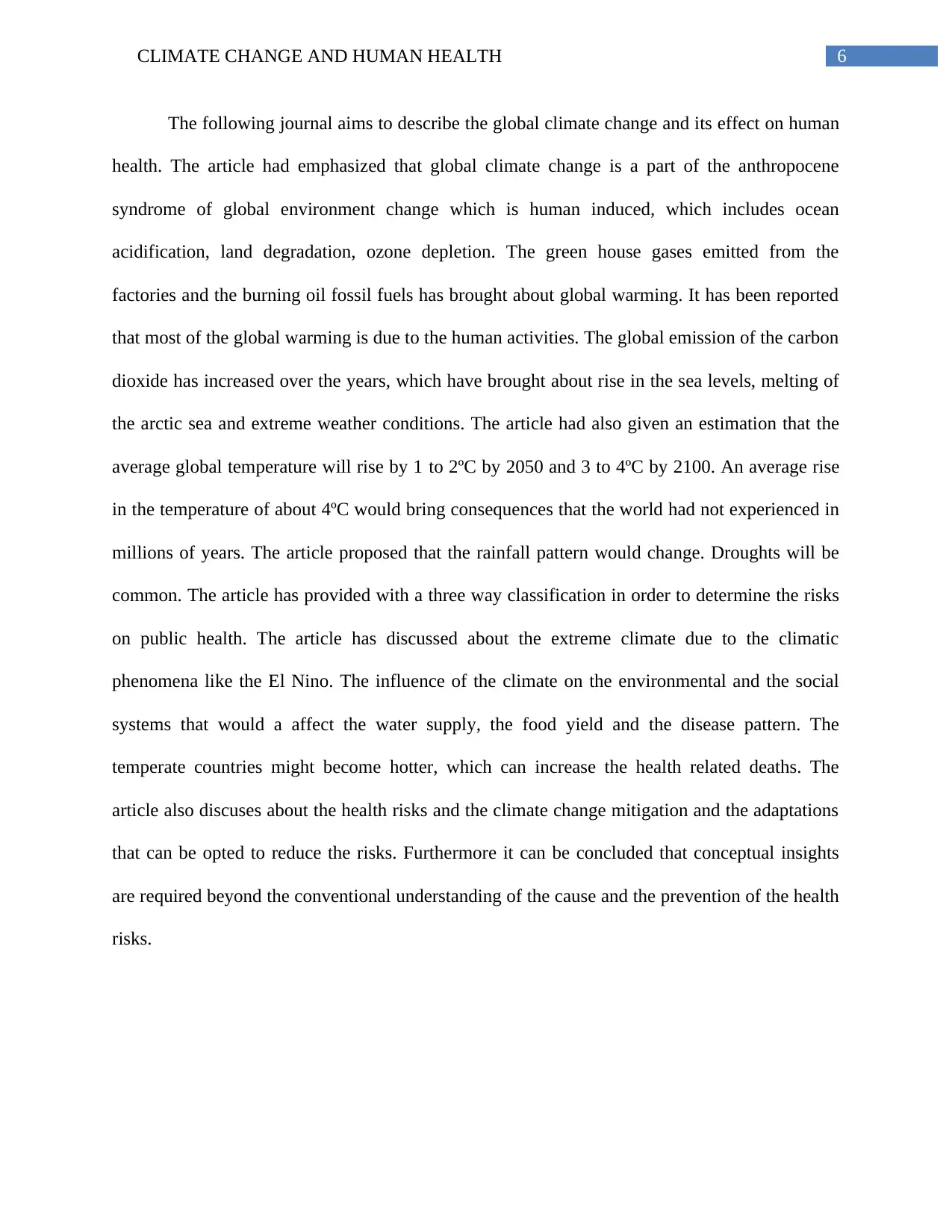
6CLIMATE CHANGE AND HUMAN HEALTH
The following journal aims to describe the global climate change and its effect on human
health. The article had emphasized that global climate change is a part of the anthropocene
syndrome of global environment change which is human induced, which includes ocean
acidification, land degradation, ozone depletion. The green house gases emitted from the
factories and the burning oil fossil fuels has brought about global warming. It has been reported
that most of the global warming is due to the human activities. The global emission of the carbon
dioxide has increased over the years, which have brought about rise in the sea levels, melting of
the arctic sea and extreme weather conditions. The article had also given an estimation that the
average global temperature will rise by 1 to 2ºC by 2050 and 3 to 4ºC by 2100. An average rise
in the temperature of about 4ºC would bring consequences that the world had not experienced in
millions of years. The article proposed that the rainfall pattern would change. Droughts will be
common. The article has provided with a three way classification in order to determine the risks
on public health. The article has discussed about the extreme climate due to the climatic
phenomena like the El Nino. The influence of the climate on the environmental and the social
systems that would a affect the water supply, the food yield and the disease pattern. The
temperate countries might become hotter, which can increase the health related deaths. The
article also discuses about the health risks and the climate change mitigation and the adaptations
that can be opted to reduce the risks. Furthermore it can be concluded that conceptual insights
are required beyond the conventional understanding of the cause and the prevention of the health
risks.
The following journal aims to describe the global climate change and its effect on human
health. The article had emphasized that global climate change is a part of the anthropocene
syndrome of global environment change which is human induced, which includes ocean
acidification, land degradation, ozone depletion. The green house gases emitted from the
factories and the burning oil fossil fuels has brought about global warming. It has been reported
that most of the global warming is due to the human activities. The global emission of the carbon
dioxide has increased over the years, which have brought about rise in the sea levels, melting of
the arctic sea and extreme weather conditions. The article had also given an estimation that the
average global temperature will rise by 1 to 2ºC by 2050 and 3 to 4ºC by 2100. An average rise
in the temperature of about 4ºC would bring consequences that the world had not experienced in
millions of years. The article proposed that the rainfall pattern would change. Droughts will be
common. The article has provided with a three way classification in order to determine the risks
on public health. The article has discussed about the extreme climate due to the climatic
phenomena like the El Nino. The influence of the climate on the environmental and the social
systems that would a affect the water supply, the food yield and the disease pattern. The
temperate countries might become hotter, which can increase the health related deaths. The
article also discuses about the health risks and the climate change mitigation and the adaptations
that can be opted to reduce the risks. Furthermore it can be concluded that conceptual insights
are required beyond the conventional understanding of the cause and the prevention of the health
risks.
Paraphrase This Document
Need a fresh take? Get an instant paraphrase of this document with our AI Paraphraser
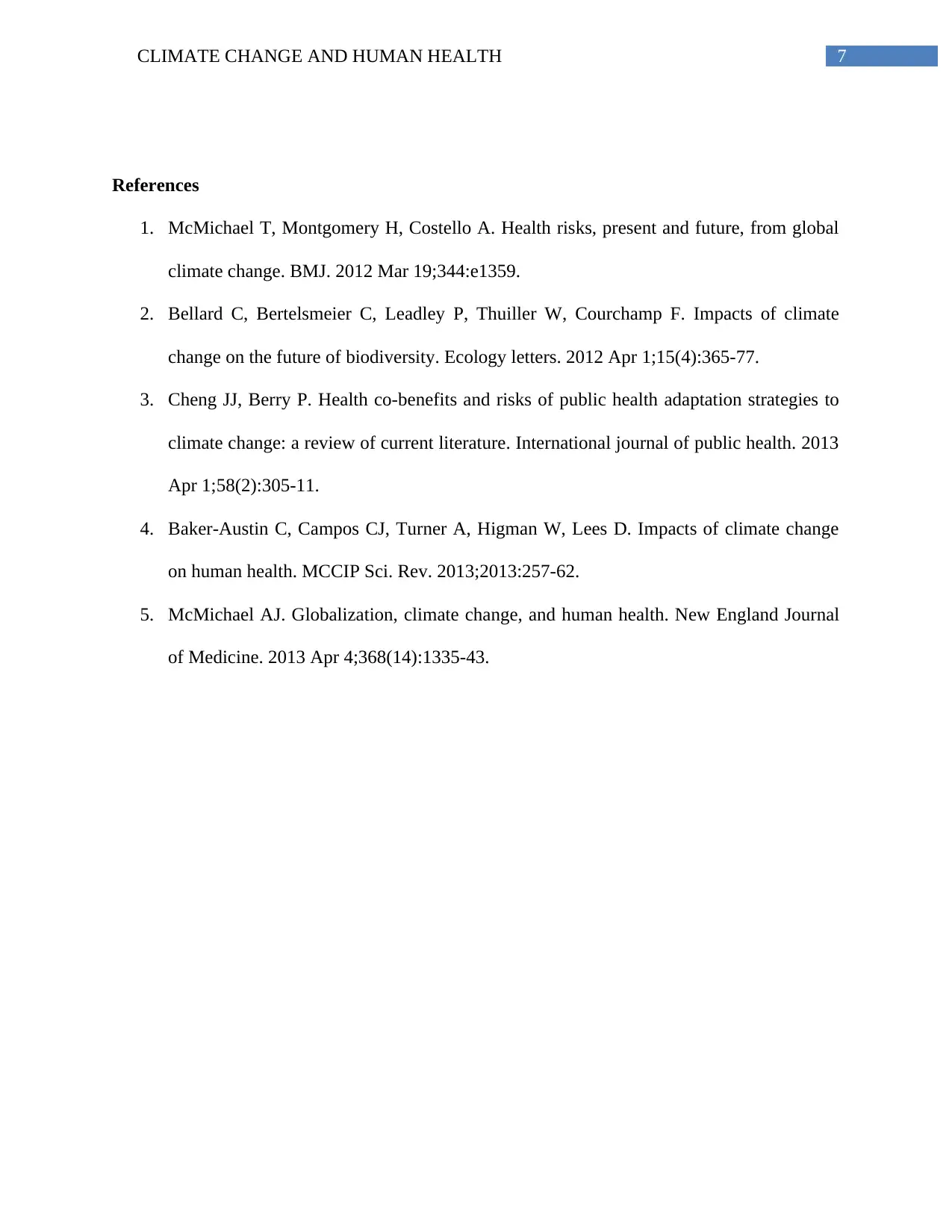
7CLIMATE CHANGE AND HUMAN HEALTH
References
1. McMichael T, Montgomery H, Costello A. Health risks, present and future, from global
climate change. BMJ. 2012 Mar 19;344:e1359.
2. Bellard C, Bertelsmeier C, Leadley P, Thuiller W, Courchamp F. Impacts of climate
change on the future of biodiversity. Ecology letters. 2012 Apr 1;15(4):365-77.
3. Cheng JJ, Berry P. Health co-benefits and risks of public health adaptation strategies to
climate change: a review of current literature. International journal of public health. 2013
Apr 1;58(2):305-11.
4. Baker-Austin C, Campos CJ, Turner A, Higman W, Lees D. Impacts of climate change
on human health. MCCIP Sci. Rev. 2013;2013:257-62.
5. McMichael AJ. Globalization, climate change, and human health. New England Journal
of Medicine. 2013 Apr 4;368(14):1335-43.
References
1. McMichael T, Montgomery H, Costello A. Health risks, present and future, from global
climate change. BMJ. 2012 Mar 19;344:e1359.
2. Bellard C, Bertelsmeier C, Leadley P, Thuiller W, Courchamp F. Impacts of climate
change on the future of biodiversity. Ecology letters. 2012 Apr 1;15(4):365-77.
3. Cheng JJ, Berry P. Health co-benefits and risks of public health adaptation strategies to
climate change: a review of current literature. International journal of public health. 2013
Apr 1;58(2):305-11.
4. Baker-Austin C, Campos CJ, Turner A, Higman W, Lees D. Impacts of climate change
on human health. MCCIP Sci. Rev. 2013;2013:257-62.
5. McMichael AJ. Globalization, climate change, and human health. New England Journal
of Medicine. 2013 Apr 4;368(14):1335-43.
1 out of 8
Related Documents
Your All-in-One AI-Powered Toolkit for Academic Success.
+13062052269
info@desklib.com
Available 24*7 on WhatsApp / Email
![[object Object]](/_next/static/media/star-bottom.7253800d.svg)
Unlock your academic potential
Copyright © 2020–2025 A2Z Services. All Rights Reserved. Developed and managed by ZUCOL.





